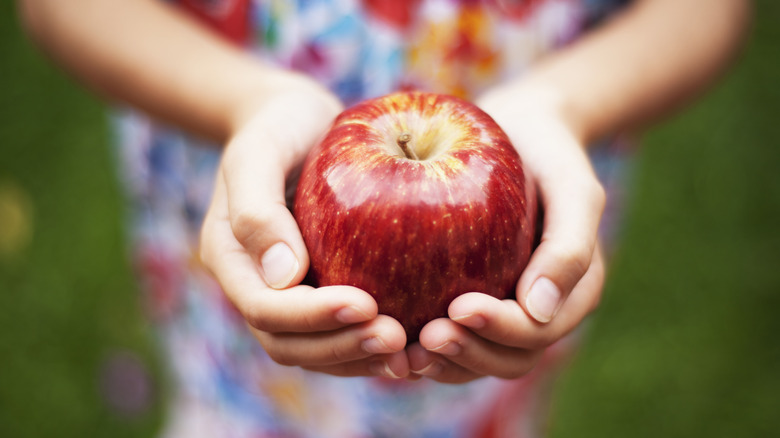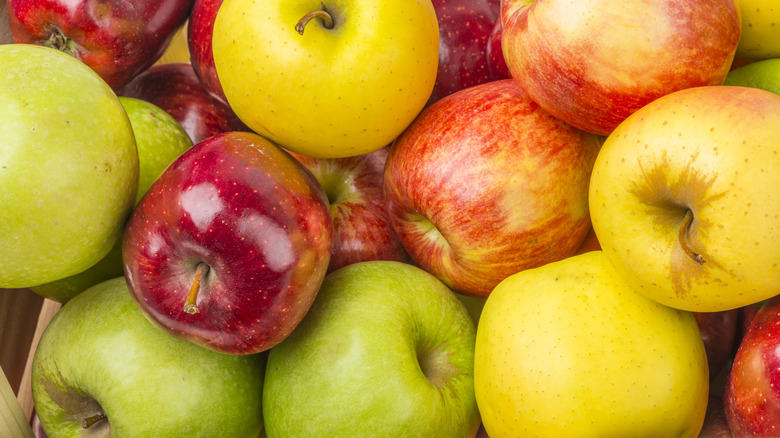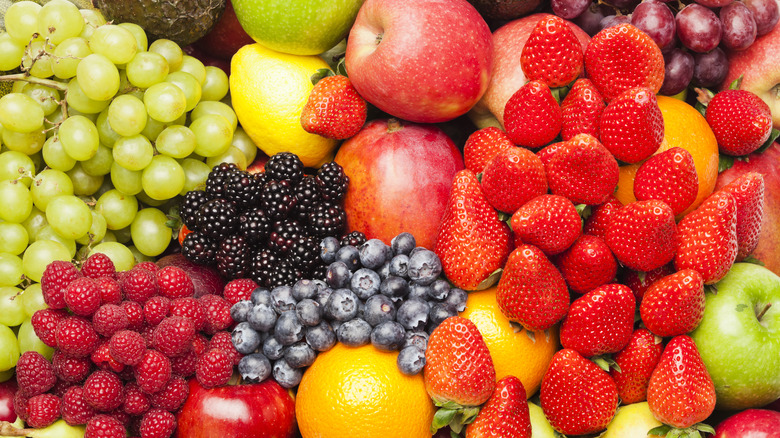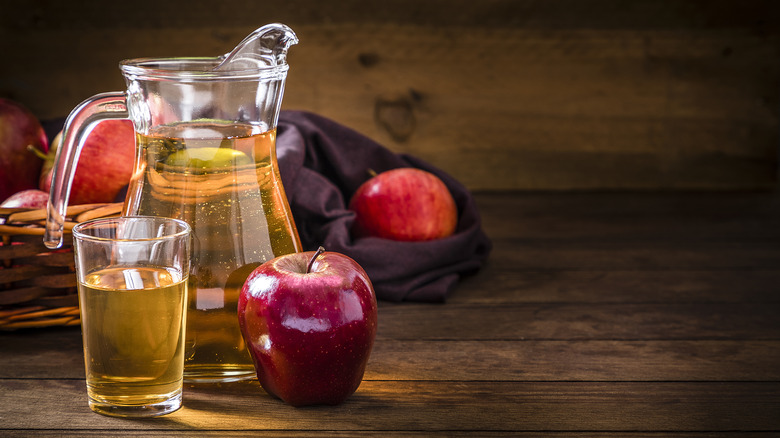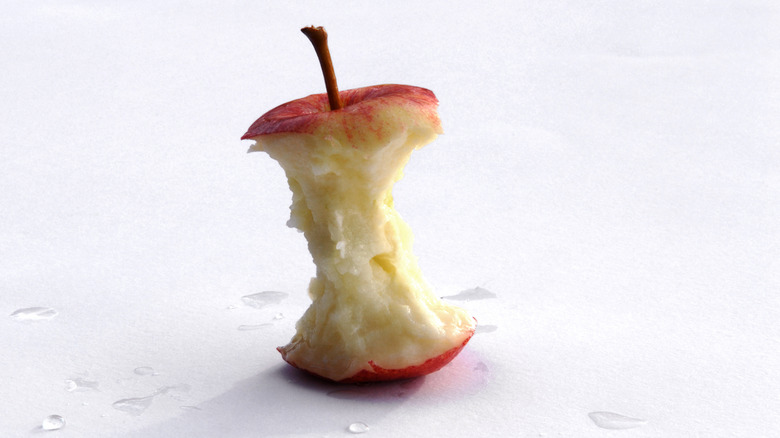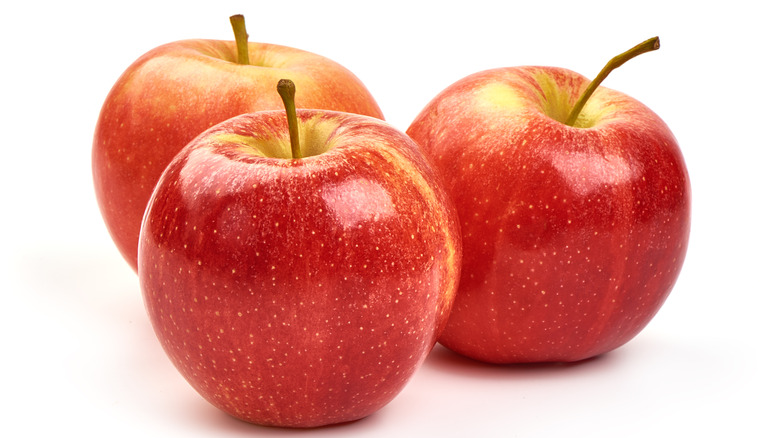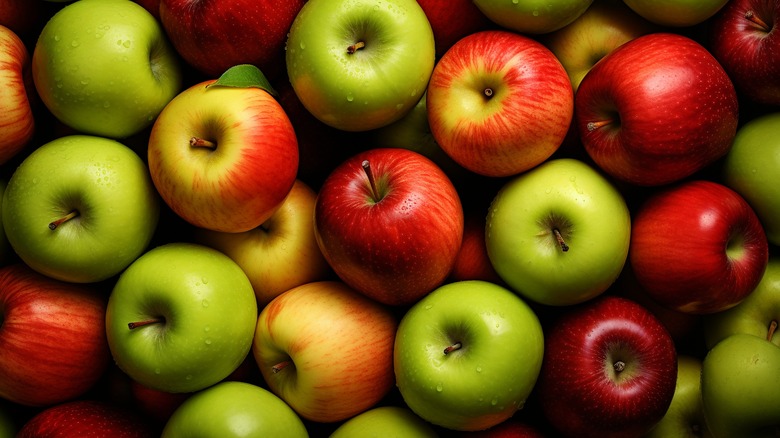False Facts About Apples You Thought Were True
In 2022, the per capita consumption of apples in the U.S. reached nearly 16 pounds, as reported by Statista. While this falls short of the proverbial apple a day, it's still a significant quantity. Given an average of three apples per pound, this amounted to approximately 48 apples per person over the course of the year.
This robust consumption highlights the enduring popularity of apples in the North American diet. Apples are not only a versatile fruit, enjoyed raw or cooked in various dishes, but they also offer numerous health benefits. Rich in fiber, vitamins, and antioxidants, apples have been credited with a host of health benefits, including improving digestion, reducing the risk of heart disease, and aiding in weight management.
The U.S. market offers a wide spectrum of apple varieties, satisfying a multitude of taste preferences. From the tart and tangy Granny Smith to the sweet and juicy Red Delicious, there's an apple type out there to suit pretty much every palate. This variety not only makes apples a staple in household kitchens but also inspires culinary creativity, as the fruit can be easily incorporated into salads, pies, and sauces.
Despite their common appeal, apples are subject to numerous misconceptions. Eager to discover the truth about this ubiquitous fruit? Read on!
False: Apples are native to the U.S.
From the iconic apple pie to apple cider, apples are ingrained in the culinary identity of North America. However, as much as they form a fabric of our gastronomic landscape, apples aren't native to the country. Instead, the roots of the smooth-skinned fruit can be traced to Kazakhstan in Central Asia when its inhabitants came across wild sour crab apples some 750,000 years ago.
It wasn't until approximately 8,000 years ago that Neolithic farmers in the region of modern-day Asia began to domesticate wild apples, beginning their transformation from a wild fruit to an agricultural staple. Over the years, the cultivation of apples continued to spread, with the fruit appearing in Britain some 3,000 years ago and reaching the shores of North America with the early settlers in the 1700s. This is when the first apple orchards were planted, significantly expanding the diversity of fruit available in the country. Fast forward to three centuries later, and we now have access to a wide assortment of appeals thanks to selective breeding.
False: There are only a few apple varieties
Given the limited selection of apple varieties found in supermarkets, it's easy to assume that apples lack diversity. In fact, these few popular apple types are just the tip of the iceberg. While 7,500 distinct apple varieties exist globally, only around 2,500 of these are cultivated in North America. This vast diversity stems from centuries of apple cultivation and cross-breeding.
The most popular apples sold in the U.S. include Red Delicious, Gala, Fuji, and Granny Smith, and these are the ones we usually see on supermarket shelves. Of course, farmers' markets, orchards, and specialty stores often carry more unique apple types.
Among the countless apple varieties, some stand out for their unique characteristics and flavors. The Knobbed Russet, for instance, is characterized by its distinctive, rough skin and sweet flesh. Another striking apple type is the Black Oxford, a fruit with dark purple skin that was first grown in Maine in 1790. Then there's the Hidden Rose apple, which features a distinctive pink flesh when it's cut open.
False: Apples are the most popular fruit
People often think of apples as the most popular fruit due to their widespread availability and versatility in culinary applications. While this isn't far off the mark, the title for the most consumed fresh fruit in the U.S. during 2022 actually goes to bananas, as documented by Statista. More specifically, 63% of the consumers surveyed reported purchasing bananas in the past year, as opposed to 58% who said that they bought apples in the past 12 months. The other most popular fruits in the States in 2022 included grapes, strawberries, watermelon, and oranges.
Globally, apples rank third in terms of fruit production, underscoring the extensive demand for the crispy fruit. Statista reports that in 2022, bananas were the most popular fruit in the world, with a production of 135 million metric tons. The second and third spots were taken by watermelons and apples, with a cultivation of 100 million metric tons and 95 million metric tons, respectively. Oranges and grapes also made the list, trailing behind apples.
False: An apple a day keeps the doctor away
We are all familiar with the proverb "An apple a day keeps the doctor away." Is eating apples on a regular basis truly beneficial for our health? The reality is that while apples are packed with essential nutrients, vitamins, and fiber that can contribute to good health, it's very unlikely that they can prevent all forms of illness. A study featured in JAMA Internal Medicine didn't find a correlation between eating an apple a day and fewer visits to the doctor. What it did find, however, is that adults who eat an apple daily are less likely to require prescription drugs.
So what's so great about apples? For starters, they are packed with dietary fiber, which is important for digestive health. Apples also contain a variety of other beneficial vitamins and minerals, including vitamin C, vitamin K, copper, and potassium. All in all, research has shown that regular consumption of apples may reduce the risk of chronic health issues such as heart disease, diabetes, and even cancer. Moreover, apples can play a role in weight management. More specifically, being high in fiber, they can make you feel full for longer, which can help reduce overall calorie intake.
False: Apple juice is as healthy as apples
Apple juice is extracted from apples, which are known for their health benefits, including being rich in vitamins and minerals. This association can lead to the assumption that apple juice retains all the nutritional benefits of the fruit. This erroneous perception is further reinforced by marketing strategies that frequently focus on the natural origins and health benefits of apple juice.
Apple juice does have numerous health benefits, albeit it's not as beneficial as eating whole apples. Since apple juice is essentially 88% water, it can contribute to daily fluid intake. Furthermore, the polyphenols — a type of antioxidant — found in apple juice may be beneficial for heart, brain, and cell health. This being said, it's important to note that the majority of polyphenols are found in the apple peel, which doesn't make it into most commercially produced apple juices. Unfortunately, apple juice also has a relatively high sugar content. Although naturally occurring, the sugar in apple juice can still contribute to increased calorie intake and potentially lead to weight gain.
False: Eating apple cores can kill you
While it may sound far-fetched, the idea that apple cores are poisonous does have some basis in fact. However, it isn't related to apple cores as much as it is to apple seeds. Apple pips contain amygdalin, which can release cyanide, a substance that turns toxic when metabolized by the human body. While even small amounts of cyanide can be detrimental to health, according to Healthline, the average person would need to finely chew and swallow around 200 apple seeds for the cyanide exposure to become fatal.
A 2019 study from the Graz University of Technology in Austria highlights that consuming the entire apple, including the core, stem, and seeds, can offer substantial health benefits. This is because this part of the apple contains 90% of the fruit's good bacteria, which are crucial for digesting food, balancing the immune system, and promoting overall well-being. Nevertheless, while eating the occasional core is unlikely to cause any issues, it's probably best not to rely on them as your main source of good digestive flora.
False: Wax on apples is artificial and harmful
Shoppers often express concern about the waxy coating on apples, believing it to be artificial and unsafe. In reality, all apples produce wax as a protective measure against insects. In addition, the thin layer of wax also preserves the fruit's freshness and extends its shelf life by slowing down moisture loss and inhibiting the growth of mold and bacteria.
Apples are frequently washed after harvest to rid them of any grime before packaging, a process that also strips away their waxy film. This is why the fruit is sometimes covered in artificial, food-grade wax. However, those concerned about the potential health implications of this needn't worry, as the entire process is regulated by the U.S. Food & Drug Administration. This means that all ingredients in the wax have been deemed safe for human consumption. Among these ingredients are natural substances such as candelilla wax, sourced from desert plants, and carnauba wax, obtained from the leaves of Brazilian palm trees.
False: Apples can't be frozen
If you come across a great deal on apples, don't fret. You can easily preserve them before they spoil. Some people mistakenly believe that freezing fruit — including apples — will completely destroy their texture and flavor. In reality, freezing fruit is actually a common and effective way to preserve its freshness, provided that you know what you're doing.
While there's no substitute for fresh produce, when done correctly, freezing fruit can be a practical solution for prolonging its shelf life. However, since freezing apples can change their texture, thawed apples are best for use in cooking or smoothies. Additionally, as a rule of thumb, red apple varieties tend to preserve their sweet flavor better when placed in the freezer than green apples, which tend to lose their tartness.
For the most manageable results, it's best to freeze apples after you peel, core, and cut them into slices. To prevent the slices from adhering together and forming a solid mass, first line them up on parchment paper. Next place them in the freezer on the highest setting to minimize the formation of ice crystals. Once the slices are completely frozen, transfer them to a freezer-safe bag. Apples can be kept in the freezer for up to nine months.
False: Cooking apples destroys all their nutritional value
Apples can add sweetness and tanginess to both savory and sweet dishes, making them suitable for a wide range of recipes. Whether incorporated into beloved classics such as apple pie and applesauce or featured in savory creations like pork chops with applesauce or salads adorned with sliced apples, this versatile fruit can elevate the flavor and texture of countless dishes.
While subjecting apples to heat can diminish their nutritional value, it by no means destroys their overall health benefits. Not peeling the apples before cooking them will help to preserve most of their fiber, as well as some phytochemicals, or antioxidants credited with boosting the immune system and preventing cellular damage. Healthpath even suggests that stewed apples may be superior to raw apples in certain nutritional respects. This is because stewing the fruit releases pectin, a type of fiber that may have gut-healing properties.
False: Red apples are healthier than green ones
People usually associate red apples with sweetness and juiciness and green apples with crispiness and tartness. According to Reddit users, it's this sweetness that makes red apples more popular with most people. It certainly stands in stark contrast with the tartness of green apples. This being said, it's important to remember that the taste of apples doesn't just depend on their hue, but also on their variety.
Regardless of their appearance and flavor differences, both red and green apples possess numerous health benefits. Nonetheless, they do differ somewhat in their nutritional content. Green apples feature a slightly higher fiber content than red apples. They are also a better source of vitamins A, B, C, E, and K, as well as protein, iron, and potassium than their red counterparts. Finally, green apples are lower in sugar and carbohydrates, making them better for those trying to lose weight. Red apples, on the other hand, generally contain more antioxidants than green apples. These include anthocyanidins, which play a key role in giving the fruit its red color.
